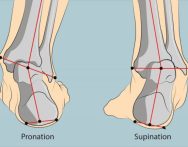
Common cricket injuries
March 12, 2017
Pronation vs. Supination
April 13, 2017A t various points in our training lives we will all find ourselves confronted with obstacles in our training goals in the way of plateaus and injuries. Unfortunately most of us won’t even consider that there may be a specific underlying weakness or imbalance that is preventing us from increasing overall strength and performance.
t various points in our training lives we will all find ourselves confronted with obstacles in our training goals in the way of plateaus and injuries. Unfortunately most of us won’t even consider that there may be a specific underlying weakness or imbalance that is preventing us from increasing overall strength and performance.
Let’s say that you know enough about your body or your client to identify a “weak” muscle or muscle group that is holding back progress. The big question is, are you dealing with a true weakness, or an inhibition? There is a big difference between the two and each will need to be approached if you are going to be able to fix the problem.
A true weakness will respond to direct training of some sort and would be indicative of an incomplete training approach, a purely inhibited muscle typically won’t. Let’s take a marathon runner (“strength” in this case is obviously a relative term given the nature of the sport). It would be pretty hard to find a serious competitive runner with truly weak calves for the obvious reason that distance running require constant use of the calves, the same would be also true for the quads too.
If you were to establish that there was a form of quad or calve “weakness” this would most likely be a result of overuse, coupled with weak antagonists (in this case typically glutes, hamstrings, tibialis anterior). The solution would more than likely lie not with more training of these muscles (quads and calves), but rather stretching, fascial release techniques and training the antagonists. THIS IS BECAUSE TIGHT/overused/dominant MUSCLES CAN INHIBIT THEMSELVES!
It would be perfectly reasonable to suspect weak glutes and hamstrings (and often overlooked, tibias anterior too) in a seasoned distance runner as these muscles are insufficiently used during distance running. These muscles would typically be weak through BOTH under-development due to lack of use during running (true weakness) AND through reciprocal inhibition (whereby the tight/overused/overactive antagonistic muscles inhibit their opposing muscle groups). Fixing this type of weakness will require both focused glute/hamstring training, at the expense of quad training AND stretching/fascial release to the tight inhibiting antagonists (calves/quads/hip flexors).
THE REALITY:
Most weaknesses are to varying degrees, a COMBINATION of underuse, lack of direct training AND inhibition due to overused/overdeveloped antagonistic (opposing) muscle groups. Optimum strength of any muscle requires one to address both! Some muscles are simply weak because they are tight and need stretching or fascial release and need to be trained less!
Final example. Hip flexors and glute max, both are often weak but for different reasons. To correct one requires the correction of the other! Hip flexors are typically tight in the vast majority of people, which leads to inhibition of their function/strength and will not effectively be corrected through direct training but rather through stretching/facial release. Glutes typically weak due to many reasons but one key is their lack of use in day to day life and training, they need direct strength training (not stretching) but the may be equally inhibited due to the antagonistic tight hip flexors. The ability to train the glutes effectively often requires the release of the hip flexors. And finally…. the key to the prevention of tight hip flexors is having strong glutes!
Gluteus to the maximus!
Dr Hassan.


